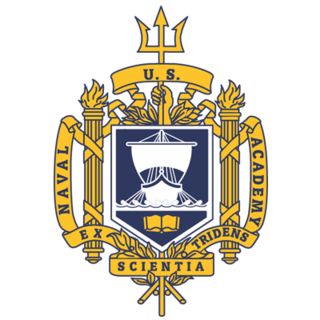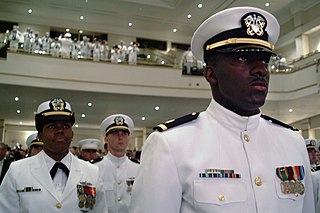Related Research Articles

The United States Naval Academy is a federal service academy in Annapolis, Maryland. It was established on 10 October 1845 during the tenure of George Bancroft as Secretary of the Navy. The Naval Academy is the second oldest of the five U.S. service academies and it educates midshipmen for service in the officer corps of the United States Navy and United States Marine Corps. It is part of the Naval University System. The 338-acre (137 ha) campus is located on the former grounds of Fort Severn at the confluence of the Severn River and Chesapeake Bay in Anne Arundel County, 33 miles (53 km) east of Washington, D.C., and 26 miles (42 km) southeast of Baltimore. The entire campus, known colloquially as the Yard, is a National Historic Landmark and home to many historic sites, buildings, and monuments. It replaced Philadelphia Naval Asylum in Philadelphia that had served as the first United States Naval Academy from 1838 to 1845 when the Naval Academy formed in Annapolis.
A midshipman is an officer of the lowest rank in the Royal Navy, United States Navy, and many Commonwealth navies. Commonwealth countries which use the rank include Canada, Australia, Bangladesh, Namibia, New Zealand, South Africa, India, Pakistan, Singapore, Sri Lanka, and Kenya.
Officer Cadet is a rank held by military cadets during their training to become commissioned officers. In the United Kingdom, the rank is also used by members of University Royal Naval Units, University Officer Training Corps and University Air Squadron; however, these are not trainee officers with many not choosing a career in the armed forces.
Sub-lieutenant is usually a junior officer rank, used in armies, navies and air forces.

The Naval Reserve Officer Training Corps (NROTC) program is a college-based, commissioned officer training program of the United States Navy and the United States Marine Corps.

The Ranks of the Imperial Japanese Navy were the rank insignia of the Imperial Japanese Navy, used from its creation in 1868, until its dissolution in 1945 following the Surrender of Japan in World War II. The ranks were inspired by the ranks of the Royal Navy.

Hector Macdonald Laws Waller, was a senior officer in the Royal Australian Navy (RAN). His career spanned almost thirty years, including service in both world wars. At the helm of the flotilla leader HMAS Stuart in the Mediterranean from 1939 to 1941, he won recognition as a skilful ship's captain and flotilla commander. He then transferred to the South West Pacific as captain of the light cruiser HMAS Perth, and went down with his ship during the Battle of Sunda Strait in early 1942.

The Royal Naval Academy was a facility established in 1733 in Portsmouth Dockyard to train officers for the Royal Navy. The founders' intentions were to provide an alternative means to recruit officers and to provide standardised training, education and admission. In 1806 it was renamed the Royal Naval College and in 1816 became the Royal Naval College and the School for Naval Architecture. It was closed as a training establishment for officer entrants in 1837.

The master, or sailing master, is a historical rank for a naval officer trained in and responsible for the navigation of a sailing vessel.
A passed midshipman, sometimes called as "midshipman, passed", is a term used historically in the 19th century to describe a midshipman who had passed the lieutenant's exam and was eligible for promotion to lieutenant as soon as there was a vacancy in that grade.
Master's mate is an obsolete rating which was used by the Royal Navy, United States Navy and merchant services in both countries for a senior petty officer who assisted the master. Master's mates evolved into the modern rank of sub-lieutenant in the Royal Navy, while in the merchant service they evolved into the numbered mates or officers.
A captain's clerk was a rating, now obsolete, in the Royal Navy and the United States Navy for a person employed by the captain to keep his records, correspondence, and accounts. The regulations of the Royal Navy demanded that a purser serve at least one year as a captain's clerk, so the latter was often a young man working his way to a purser's warrant. He had high status, with an office on the quarterdeck or upper deck on most ships. He was paid at the same rate as a midshipman in 1800, but by 1815 he had almost the same monthly pay as a standing warrant officer. On large ships, he had his own cabin in the gunroom, but on smaller vessels he lived with the midshipmen on the orlop deck.

The Selborne-Fisher scheme, or Selborne scheme, was an effort by John Fisher, 1st Baron Fisher, Second Sea Lord, approved by William Palmer, 2nd Earl of Selborne, First Lord of the Admiralty, in 1903 to combine the military (executive) and engineering branches of the Royal Navy. The main goal was to return control over the movement of a ship to the military officer.
Midshipman ordinary, or midshipman-by-order, refers to an obsolete rating for prospective officers in the British Royal Navy. The rating was specifically applied to graduates of the Royal Naval Academy who had earned their sea time in a classroom instead of serving at sea.
Young gentlemen is an archaic term that was used in the Royal Navy to refer to boys aspiring to become a commissioned officer. Until promotion to lieutenant, these boys would serve in various ratings, and the term was used to group all these boys together. A similar term today would be officer candidates or cadets.
The US Navy had four programs for the training of naval aviators.

Wat Tyler Cluverius Jr. was an admiral in the United States Navy and president of Worcester Polytechnic Institute. When he died, he was the last surviving officer of the sinking of USS Maine.
Peter Rainsford Brady was an American military officer, surveyor and politician. Following a short service in the United States Navy he joined the Texas Rangers, where he served during the Mexican–American War and along the western frontier. From Texas he moved westward where he became an early settler and political office holder in Arizona Territory.

Royal Navy ranks, rates, and uniforms of the 18th and 19th centuries were the original effort of the Royal Navy to create standardized rank and insignia system for use both at shore and at sea.
The Confederate States Naval Academy was an undergraduate academy in Richmond, Virginia, of the Confederate States of America that educated and commissioned officers of the Confederate States Navy. The CS Naval Academy was established by an act of the Confederate States Congress on April 21, 1862, and graduated a number of midshipmen before being disbanded on May 2, 1865, in Abbeville, South Carolina, subsequent to the fall of the Confederate States.
References
- Lewis, Michael (1939), England's Sea-Officers, London: George Allen & Unwin, OCLC 1084558
- Penn, Geoffrey (1957), Snotty: The Story of the Midshipman, London: Hollis & Carter, OCLC 8317840